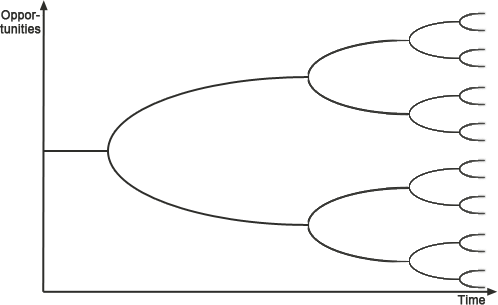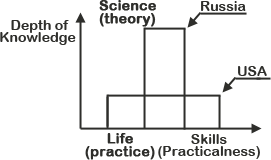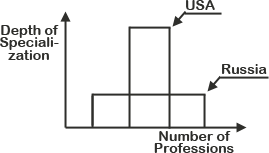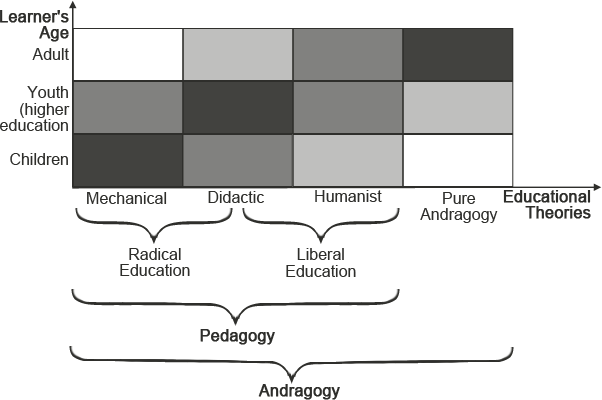![synergist.kiev.ua <? print trim($names[$l]) ?>
synergist.kiev.ua](images/head3.png)
 |
 |
 |
![synergist.kiev.ua <? print trim($names[$l]) ?>
synergist.kiev.ua](images/head3.png) |
|
 |  |  |  |  |  |
Elena Pugacheva, Synergetic Approach to Education:
|
|||||||||||||||||||||||||||||||||||||||||||||||||||||||||||||||||||||||
 |
Scheme 1. Bifurcation Tree of Opportunities. |
Synergetics considers process of development not as planned movement to the purpose, but as an iterative process, at each stage of which the choice, determining the way of further development, is executed.
The development of social system as a nonlinear system passes two stages: evolutionary stage and bifurcation. A distinctive feature of the evolutionary stage is the constancy of system quality. This is the period with well-predicted linear changes. But just here the increase of internal nonequilibrium occurs. It is felt as an approach of crisis. The system comes to the point of bifurcation. In this point the evolutionary path of the system is branched out. The choice of that or other way in the point of bifurcation depends on the factor of chance. It is implemented through the activity of particular people. It is a historical person who removes a system to a new system quality, determining the destiny of millions of people. The role of chance is not only great. It is fundamental. It makes the process of historical development irreversible. From synergetic point of view the future can be seen as the space of opportunities, and present - as an intensive process of choice.
The majority of the researchers recognize that humankind has come nearer to a condition of unstable balance or bifurcation. Further destiny of a civilization depends on the possibility of mankind to change their way of life.
There are many bifurcation moments in the history. Up to now the society overcame them spontaneously. It was not coordinated with the development of the nature and society. A feature of the present moment is that the casual approach can lead to the catastrophe of
civilization.
At the same time mankind now possesses advanced collective intelligence, capable to evaluate the character of approaching crisis and find the reasonable decision, excluding world-wide destruction. But today science and education are not ready to head the directed search of social transformation. The transition to a new anthropological level is impossible without serious research work and responsible choice in order get into the attraction area of the desired future.
Since the 18th Century the science has become the productive force of the society. This era
began with the development of large industrial manufacture and proceeds so far.
Simultaneously science, being subject to policies, increases the military force of the society (defensive, restraining, and offensive). At the same time the science, probably, has never in the history played a decisive role in the questions of social choice. Although the idea to concentrate a state authority in the hands of the scientists can be found even in the ancient times, for example in Platon's works. To a greater or lesser extent this idea displayed itself in overwhelming number of Utopias.
The science was never considered as a serious competitor of a policy. The minor role of science in public life (science as the social force) reveals itself in political decisions accepted by the people in democratic countries. These decisions are frequently emotional not rational. As a result, the acceptance of key decisions for the society has casual character.
There are three channels of scientific influence on the society.
1. POLICY:
2. PUBLIC EDUCATION. Popularization of scientific views through the channels accessible to the general public (radio, TV and so on).
3. EDUCATION. Formation of scientific outlook in the society.
In this case, people can produce more objective valuation of the events. The variety of scientific schools and availability of their views to general public could make the choice more reasonable. It should be noticed that today education is not directed to form an integral world-outlook. At best, now education gives scientific fragments of the world, which are, as a rule, not connected with one another and which do not cover all person's needs leaving a white stain.
Some characteristics of these three channels are submitted in Table 1.
We believe that education is the most effective channel of scientific influence on the society. The fact that education is putting forward in a number of the central factors of social development results in an idea of transforming educational establishments in more responsible educational environment built not on the mechanical principles of the 20th Century, but in the logic of the world self-organization concept.
According to the new educational paradigm (its main clauses are stated in the documents of Goskomvuz of Russia and the Memorandum of International Symposium UNESCO "Fundamental (natural and humanitarian) university education, 1994), it is necessary [9]:
If the former education paradigm was essentially the paradigm of training, proclaimed knowledge, skills and education, the new one means the development of the creative qualities of a person.
On the other hand, the discovery of the mechanism of self-organization was among the most important events of the 20th Century. It was proved that open systems evolve, and it is only closed systems that move to entropy according to the Second Law of thermodynamics [10]. It is openness (the system is referred to as open, if it exchanges energy, substance and information with its environment) in combination with interaction and nonlinearity that makes the system capable of creating new forms and structures [11].
Openness and self-organization can be the basis for a new educational paradigm. The main ideas of our variant of such a paradigm are presented in [12-14]. In this paper we shall consider two aspects of educational reform:
The characteristic features of Russian higher education are the excess of theoretical material and the lack of practical knowledge that a graduate can apply at once, when coming to the work place. Another extreme of education - only practice, a set of skills, ready recipes, taken from life, without generalisation, interrelation and deep understanding - is observed in some American institutions of higher education. It happens when the main purpose of knowledge is its application in life. If a decision has brought success to a very smart businessman, why not use it, even if you are a beginner in business.
Our colleague drew a scheme of higher education in Russia compared to that in the USA (see Scheme 2):
 |
Scheme 2. omparison of Russian (radical) and American (liberal) Approaches to Education. |
In general this scheme is valid for making a comparison between radical (Russia, Japan, England, France and other countries) and liberal (USA and many countries of the West) approaches to education. On the other hand, the theoretical depth of Russian training makes it possible to obtain several adjacent professions. Graduates are not so narrowly educated as, for example, in the USA, where they have a thorough knowledge but in a narrow area. That is Scheme 3 also valid.
 |
Scheme 3. Depth of Specialization and Number of Professions in the Case of Radical and Liberal Approaches to Education. |
The ideal variant is obviously something between the radical and liberal approaches. Our colleague represented this golden mean by the scheme, similar to Scheme 4. We developed our own variant, namely, Scheme 5.
 |
 |
Scheme 4. Transition from "T-system" to "Frog's Paw". |
Scheme 5. Transition from "T-system" to "Palms". |
It's clear that the radical and liberal parts form together a figure similar to an inverted letter T. For brevity hereinafter we shall name this structure the "T-system". In the schemes 4 and 5 "T - systems" are marked by a dotted line. The area of figures depicted in schemes 4 and 5 (volume of educational material, time and attention spent by the students and so on) is approximately equal to the area of the horizontal and vertical rectangles of the "T-system". Nevertheless, this "prickly fan", "maple leaf", "frog's paw" or "Palms", as you want, has the merits of both rectangles.
For brevity hereinafter the result of transformation of "T-system" we shall name "Palms". In this model "Fingers" represent fundamental disciplines, "Wrist" - the joining of the theory with practice.
We understand that it is not easy for teachers to make a "frog's paw" from any two rectangles. It is necessary for Russian theorists to become marketing specialists. They should do some serious work in the sphere of marketing enterprises. It is essential that both Russian and American teachers should co-ordinate their efforts with teachers of adjacent specialities. Certainly, it's easier to say than to do. But, perhaps, this frog will become our princess. (сноска 1)
Quality Criterion There is a question: which of the Fingers of the "Palms" should be longer, and which shorter? The answer is almost obvious: long Fingers should support by their fundamental basis short Fingers and the membrane between them. As a result we obtain the quality criterion: the longer the Finger the more connections it has with the other parts of the "Palms". In other words: for such a deep fundamental course to be justified, its existence should be of great significance to the other disciplines of training.
For example, one such course is the functional analysis course for mathematicians or the management course for managers. Thus, the transformation of "T-system" into "Palms" may be regarded as unsuccessful if its long Fingers have no connections with the others. Such Fingers can be considered as the first candidates for shortening.
Revision of Basic Courses The reorganisation of the "T-system" should rouse teachers of each speciality to revise the basic courses. It should be done in two directions:
To make the best of this idea, it is necessary to move in both directions: downward and upward. Now we shall analyze these directions and then return to a general discussion of "T-system" reorganization.
The revision means the attempt to find general knowledge that lies in the basis of all disciplines of some speciality. For example, let us consider a situation, where three courses make the foundation of the speciality (see Scheme 6).
 |
Scheme 6. Construction of the New Fundamental Course N from Former A, B and C. |
The fundamental courses A, B and C are the base for three applied disciplines. The intersection of these courses is shaded. It is ideal to construct new minimum course N (marked in the scheme by dotted line), which could be the base for our applied disciplines. The new course, probably, would include the intersection of A, B and C. At the same time the new course N would be essentially less than their mechanical combination. That is, probably, the following enclosures are valid:
| (A ∩ B ∩ C) ⊂ N ⊂ (A ∪ B ∪ C) | (1) |
By the large, perhaps, the new course N doesn't enclose some or all parts of the set
(A B C). It can completely be covered by A. Maybe it is a new science. Perhaps, it is synergetics, or its part?
Almost obviously, it is possible to construct many new courses: N1,N2, N3,... The minimum of all candidates, the easiest to understand and the most logical will be, probably, an andragogy ideal. On the other hand, as a fundamental course it should satisfy more disciplines of our speciality than others.
The following question deserves special consideration. Which disciplines of the speciality should new basic courses be built? Here are some variants of answers:
 |
Scheme 7. Searching for the New Applications of Fundamental science. |
 |
Scheme 8. Combinations of Fundamental Sciences and Their Applications. |
This construction is represented in Scheme 7. The problem is to find as many applications as possible. In such a way the column is transformed into а bell-mouth marked in the scheme by a dotted line. It is reasonable to cover as many applied disciplines as possible by this bell-mouth. As shown in Scheme 8, science A can be excluded from education because B covers all its enclosures. However, science A may be excluded only if course B has been already taught. Otherwise, it seems unreasonable to replace small course A by huge course B if there are no other specialities in B except specialities A.
And what about course C? Is it reasonable to exclude the segment [KL]? Is it possible to construct a course D (marked by a dotted line in the scheme) that covers the segment [KL]? The question is whether it is better to teach courses B and D, or only A, or A and C? At first sight, there are many questions. Certainly, it is possible to formalize the decision-making procedure.
Synergetics is one of the most promising candidates for such fundamental science.
It's common knowledge that students of the liberal and most of the West's radical higher schools are being prepared to live among people much better than students in Russia. It should be noticed that foreign experts of higher education, nevertheless, give importance to similar questions (see, for example, [15]). We would like to express our concern in this connection. In our view, at least, the following areas should be improved in Russia.
According to our own experience and the opinion of our respondents, the question of choice of educational methods is not something requiring explicit attention. And it's quite clear: state education in Russia is surviving, and non-state education is coming into being. Attention to educational methods can help both to survive and to become stronger in the market of educational services.
Let's assume that there is a connection between subject, method, and result of education (see Table 2).
One of the disadvantages of radical education is the lack of practical skills. At the same time, good practical skills without deep theoretical knowledge (liberal education) can create illusion, that you are able to execute any task. The ideal is something in between, when the student will be able:
The fulfilment of item 2 is the consequence of a person's openness. Realization of item 3 is self-organization.
It seems to us that Malcolm Knowles's andragogy could be a good educational technique in the framework of "Palms". Let's illuminate in brief some thesises of andragogy. All citations are taken from [16].
Brief Review of Andragogy. There are three large groups of education theories, which follow from various models of the person:
Each model has its own strategic directions for education. For mechanical theory, it is a certain set of instructions, according to determined program: training machines, rectilinear instructing with the help of a computer, drills.
For the cognitive model, the didactic instructions, mechanical memorizing of information,
methods of analysis (for example, the way of problem decision) and uniform standardised tests are ordered.
For the humanist (organic) model, research methods, individual programs of training using self-education are typical.
...The representatives of the mechanical model - Pavlov... and others - insist that training occurs only when the pupil begins to give the right reaction to a certain irritant. ...The supporters of cognitive theory - Piadget... and others - believe that training occurs only when the pupil learns the principles checked by time and masters the critical thinking strategies of decision making. ...Theorists of the humanist approach - as briefly formulated by Carl Rogers - recognize that training is possible only under condition of educational freedom. It is stimulated by a particular individual desire to get education".
"...mechanical model is more preferable when worker is supposed to receive base knowledge. In the cases when it is necessary to learn or to analyze anything, the didactic methods are more suitable. But in more complex situations requiring high level of self-development the humanist approach is indispensable". (Notice: as to our experience the humanist model proves itself in Russian higher education, as an effective approach nicely perceived by the students).
These three groups of educational models are referred to as pedagogical. Andragogy is an emerging technology for adult learning. "The most important and essential assumptions concerning adult education are:
"Andragogy model is the model of the process that can include various principles and methods, thus saving integrity. Educator (adviser, assistant) beforehand prepares only the complex of measures accelerating the process of learning. In contradistinction to pedagogical approach, the main idea of andragogy is acquiring knowledge (not the way of its transferring). Educators see the problem in two ways: firstly, as the designers and managers of the educational process, and secondly, as a source of this knowledge. The second item means the opportunity to connect the learner with other sources of information (something like the information broker)".
The fitness of different educational theories depending on the learner's age is represented in Scheme 9.
 |
Scheme 9. Fitness of Different Educational Theories for Training People of Different Ages. (The more dark the colour, the closer these theories to given age). |
It seems to us that mechanical and didactic theories to a great degree correspond to the radical approach, while didactic and humanist - to liberal one. Although "Palms" is intended for higher education (youth), we recognize that there are no reasons to refuse it as an educational method for other categories of learners. Moreover, for continuity of education, it is reasonable to use approaches in accordance with the ages.
Let’s consider briefly the application of andragogy in "Palms".
Andragogy attracts us by its flexibility and openness. It comprises different (including pedagogical) methods of training, naturally involving the whole world in the interaction of the educator with the learner, that is acting maximally open. Andragogy - as a technique of training - is one of the best tools in self-organizing of educational process. At best, the educator can excite the curiosity about something and convince the learner the necessity of this knowledge. In the case of good textbooks, courses and so on the process of education is simple. It is a technical result of educator's work. Bad textbooks and the unsuccessful structure of courses will make the process of education difficult or upset it in general.
The best way of education is: andragogy -> humanist -> didactic -> mechanical, from the maximum development of a person and maximum simplicity and interest in training (andragogy) to minimum development and volume of knowledge necessary for work and life (mechanical theories). It will guarantee differential approach to a learner. It is important that everyone has an opportunity to receive higher level of training (from mechanical to andragogy). Probably, the main cares of an educator will be to move learners upward. Taking into account the individual character of distance education, it may be the best way to realize this approach.
Certainly, the choice of educational methods, stated above, is not a dogma. We understand that this choice depends not only on the discipline, but also on the teachers and their pupils. Our ideal teacher is the manager of the educational process, freely possessing all methods of training, and choosing the most suitable among them for a given audience in order to reach the best educational results.
Certainly, it is reasonable to begin with the bases (from the tips of Fingers). At the same time, it is desirable that the acquiring of social and technical skills (to speak, to write, to use a computer and so on) and philosophy studies should begin from the very beginning (from the first year of education). It is essential that the way from "Long Fingers" of the "Palms" to "Wrist" should be as short as possible (see Scheme 10, variant (a)).

|
 |
||
|
Scheme 10. Examples of Good Arrangement of Disciplines to be Studied by "Palms" (1, then 2, then 3). |
Scheme 11. An Example of an Unsuccessful Arrangement of Educational Disciplines. |
If it were done in the first semester, the education wouldn't be boring, because one could see applicability of the theory in life. Sometimes it is difficult to get quickly to the "Wrist". Then it is possible to divide the whole "Finger" into parts, some of which begin in the middle of the "Finger" (see Scheme 10, variant (b), figure 1). For example, the functional analysis for mathematicians begins with the study of mathematical analysis, which is its particular, more simple case possessing, however, many applications. The example of an unsuccessful arrangement of educational disciplines is represented in Scheme 11.
The additional way to speed up applicability of the theory is to think of business games (see, for example [17]). In fact they are real, but simplified, industrial problems. Because of their simplified character, business games could be applied in the educational process early. By gradually complicating them, it is possible to reach the level of present industrial problems.
Ideas of "adult education" [16], "nation of learners" [15], and "lifelong learning" [18] are not new in the West. These ideas are actual in Russia too. We shall note with pride: as long ago as 1913. V.I.Vernadsky wrote, that future life of mankind would be the form of organization of "learning people", which would become the basis for the wide and peaceful development of mankind [19].
Is it reasonable to use "Palms" in post-higher education? Yes, if:
Marketing service will prompt what is necessary to learn, while "Palms" will help to arrange the structure of courses and, finally, andragogy will use the methods of education.
The information explosion, fast shifts in technologies, and so on force many enterprises to study, to change constantly in order to survive in the competitive struggle. Today, higher education must also study in order to survive and flourish (perhaps, it sounds paradoxical). From our point of view it means the following:
Realization of items I - III is a gear in higher education self-organisation as open socio-technical system 3
We risk getting in a situation: constructed "Palms" will be inadequate given the new requirements of a changing society. But it is marketing that can tell what specialists are in demand. And only if we build our "Palms" together with the marketing service it will form a strong handshake with the market. In other words
"Palms" is a maximally open (on the world scales) construction. It is the continual process of knowledge self-organization. As a result, we receive a variety of world pictures for the best transfer of this knowledge to new generations; as a consequence - for more effective manufacture and, on the whole, - the best satisfaction of society's needs.
The paper was published in:
 |
|
At full or partial use of data from the «Synergist» site, the reference to the authors and to the site is obligatory. In case of Internet publication an active hyperlink on http://synergist.kiev.ua is obligatory. |
|||